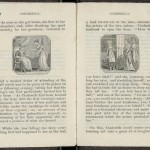Coming across, so far, three versions of the story of Cinderella during McGill’s Chapbook Digitization Project, I thought I would share a short comparison between the three, in no particular order:
Version 1:
Title: The History of Cinderella; or, the Little Glass Slipper
Printed: Otley, England by William Walker
Date: 1813
Excerpt: “ Her movements were so graceful, and her dancing performed with such nice, and, at the same time, easy exactness, that the admiration of the whole assembly was raised to the greatest height, and every part of the room resounded with loud bursts of applause.” (p. 22)
Unique to this version of the Cinderella story (from the other two) is its numerous wood-cut engraving in the shape of either a rectangle, and more commonly within the text, the shape of an octagon. Furthermore, this Chapbook includes a few stanzas of verse throughout the text alongside the main story line.
Version 2:
Title: The Surprising Adventures of Cinderilla; or the History of A Glass Slipper to which is added An Historical Description of the Cat
Printed: York, by J. Kendrew Colliergate
Date: 1820
Excerpt: ” The King’s son conducted her to the most honourable seat and afterwards took her out to dance with him. She danced so very graceful, that they all more and more admired her.” (p.17)
One of the key distinctive features of this version of the story is the spelling of the protagonist’s name. Cinderella is most commonly spelled with an “e”, however, this Chapbook has published the name with an “i”. Furthermore, unlike the other two versions, this Chapbook includes a section for the alphabet before the main body of the text as well as adds a juvenile section towards the end of a description of a cat.
Version 3:
Title: Cinderella or, The History of the Little Glass Slipper
Printed: Philadelphia, Pennsylvania by Mathew Carey
Date: 1800
Except: “The king’s ſon conducted her to the moſt honourable ſeat, and afterwards took her out to dance with him. She danced so very gracefully, that they all more and more admired her.” (p.21)
This particular version of the story of Cinderella is a facsimile (an exact reproduction of the original copy) that was acquired privately by the Huntington Library in 1951. According to the printed note at the beginning of this copy, it is “the earliest known American edition of Cinderella”. Mathew Carey, the publisher of this copy, was an Irish immigrant who came to Philadelphia in November 1784. The note further mentions that the text of this version may have been derived from Charles Perrault‘s collection of stories, first published in the late 17th century.
As displayed by the above excerpt, the text closely follows the standard version of the story (Version 2 above also demonstrates this). However, unlike the previous version, this publication includes numerous Latin S‘s, ct-ligature, signature characters, and wood cut oval-shaped images.















